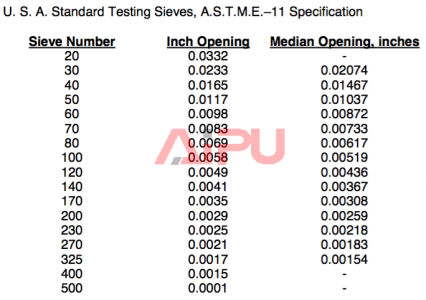Shaker screen API is another mean indicating screen mesh size but more standard and compatible. Please find more information as below
Shaker screen API

Shaker screen API - test sieves
Many clients asked us this question, how to revert API to micron of separation point/cut point or mesh for shaker screen mesh,even many of shaker screens manufacturers do not know this well. Some manufacturers use the API number as mesh directly, this is incorrect, if clients do not have professional knowledge, they will use the wrong mesh screens and can not get the ideal result.
Here we will introduce how to revert API to micron for shaker screens. Take below shaker screen designation as example. Since different manufacture will have different screen designation and configuration
| Mesh Conversion table | ||
| Mesh designation | Micron | API number |
| 20 | 840 | 20 |
| 30 | 590 | 30 |
| 40 | 420 | 40 |
| 50 | 297 | 50 |
| 60 | 250 | 60 |
| 70 | 210 | 70 |
| 80 | 177 | 80 |
| 100 | 149 | 100 |
| 120 | 125 | 120 |
| 140 | 105 | 140 |
| 170 | 88 | 170 |
| 200 | 74 | 200 |
| 230 | 62 | 230 |
| 270 | 53 | 270 |
| 325 | 44 | 325 |
This is a chart to show how to convert mesh to microns, to know how to convert microns (D100 separation), then to know how to convert mesh to API, or API to mesh
We ever introduced many different mesh sizes from different models and makes shaker screen. Lets take following chart as another reference
| Mesh Conversion table | ||
| Mesh designation | Micron | API number |
| XL024C | 779 | 25 |
| XL038C | 590 | 35 |
| XL050C | 420 | 50 |
| XL070C | 297 | 60 |
| XL084C | 250 | 70 |
| XL105C | 210 | 80 |
| XL120C | 177 | 100 |
| XL150C | 149 | 120 |
| XL165C | 125 | 140 |
| XL200C | 105 | 140 |
| XL220C | 88 | 170 |
| XL230C | 74 | 200 |
| XL270C | 62 | 200 |
| XL325C | 53 | 230 |
| XL360C | 44 | 270 |
Shaker screen mesh standard
According to above chart and information we find mesh size or designation from different suppliers will indicate various separation point or D100 cut point then come to certain API size according to latest API RP13C.
Some convert chart for separation point and API size are based on D50 or D84. Those are former version API standard on screen designation. Now almost shaker screens are in compliance with API RP13C.
Aipu shaker screen API number is tested under API RP13C code. We are able to provide you all makes and models shaker screen in oilfield all over the globe. Please contact us for more detail and information on API size convert to mesh size


